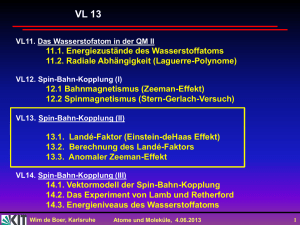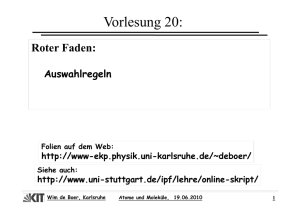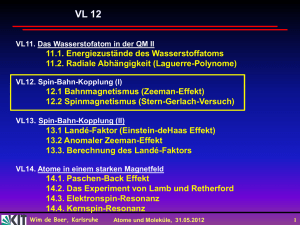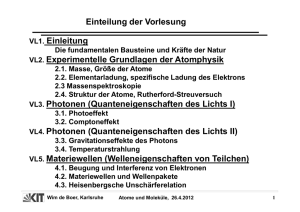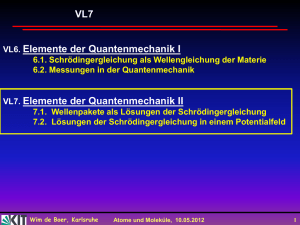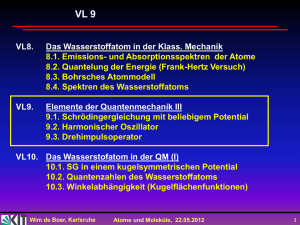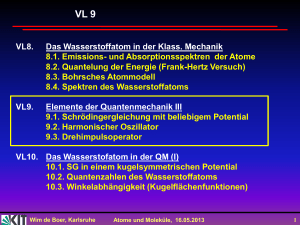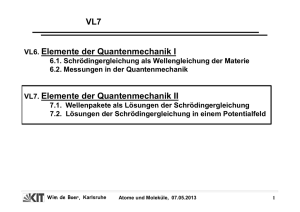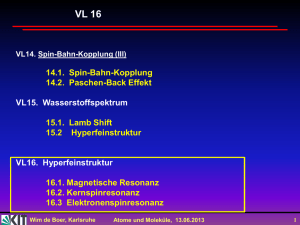Wim de Boer, Karlsruhe Atome und Moleküle, 5.06.2012 1
Werbung
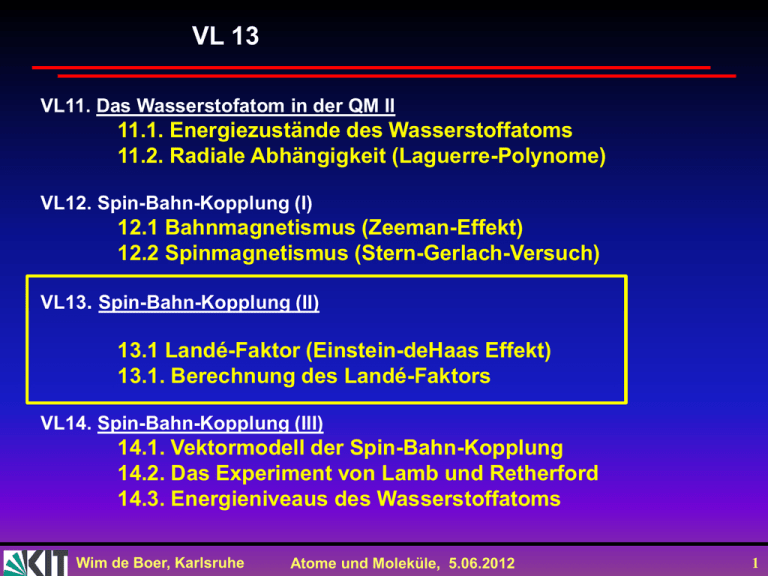
VL 13 VL11. Das Wasserstofatom in der QM II 11.1. Energiezustände des Wasserstoffatoms 11.2. Radiale Abhängigkeit (Laguerre-Polynome) VL12. Spin-Bahn-Kopplung (I) 12.1 Bahnmagnetismus (Zeeman-Effekt) 12.2 Spinmagnetismus (Stern-Gerlach-Versuch) VL13. Spin-Bahn-Kopplung (II) 13.1 Landé-Faktor (Einstein-deHaas Effekt) 13.1. Berechnung des Landé-Faktors VL14. Spin-Bahn-Kopplung (III) 14.1. Vektormodell der Spin-Bahn-Kopplung 14.2. Das Experiment von Lamb und Retherford 14.3. Energieniveaus des Wasserstoffatoms Wim de Boer, Karlsruhe Atome und Moleküle, 5.06.2012 1 Vorlesung 13: Roter Faden: Landé-Faktor (Einstein-deHaas Effekt) Berechnung des Landé-Faktors Folien auf dem Web: http://www-ekp.physik.uni-karlsruhe.de/~deboer/ Siehe auch: Demtröder, Experimentalphysik 3, Springerverlag Und http://www.ipf.uni-stuttgart.de/lehre/online-skript/f30_11.html Wim de Boer, Karlsruhe Atome und Moleküle, 5.06.2012 2 Zusammenfassung Elektronspin Wim de Boer, Karlsruhe Atome und Moleküle, 5.06.2012 3 Räumliche Einstellung eines Drehimpulses Eigenfunktionen des Drehimpulsoperators sind die Kugelflächenfunktionen.Für jedes Paar Quantenzahlen l,m gibt es eine eigene Funktion Yl,m(,φ) (später mehr) Wim de Boer, Karlsruhe Atome und Moleküle, 5.06.2012 4 Präzessionsversuch (KM) Beobachtung: drehendes Rad fällt nicht, sondern dreht sich in horizontaler Ebene. Erklärung: D Gewichtskraft übt Drehmoment in horizontaler Richtung aus und M=mgD=dL/dt schiebt L0=J0 0 in die horizontale Richtung! Diese Bewegung nennt man Präzession. Präzessionsfrequenz aus M=dL/dt=L0d /dt=L0 p oder p=M/L0=M/J00 dL = L0d L L0 = J0 0 Wim de Boer, Karlsruhe Atome und Moleküle, 5.06.2012 5 Präzessionsversuch (Spin) Beobachtung: Spin nicht parallel B, sondern dreht sich in horizontaler Ebene. Erklärung: B S Magnetfeld übt Drehmoment in horizontaler Richtung aus und M=xB=-gS (e/2m)B Ssin =B S sin schiebt S sin in die horizontale Richtung! = gyromagn. Verhältnis. Präzessionsfrequenz aus M=dS/dt=Ssind /dt= Ssin L oder L=M/ Ssin = -Bsin /Ssin =-B dS = Ssin d Ssin Wim de Boer, Karlsruhe Atome und Moleküle, 5.06.2012 S 6 Einstein-de Haas-Effekt ħ Wim de Boer, Karlsruhe Atome und Moleküle, 5.06.2012 7 Einstein-de Haas-Effekt ħ ħ ħ ħ Wim de Boer, Karlsruhe Atome und Moleküle, 5.06.2012 8 Einstein-de Haas-Effekt Wim de Boer, Karlsruhe Atome und Moleküle, 5.06.2012 9 Magnetisierung Wim de Boer, Karlsruhe Atome und Moleküle, 5.06.2012 10 Diamagnetismus und Paramagnetismus Wim de Boer, Karlsruhe Atome und Moleküle, 5.06.2012 11 Einstein-de Haas-Effekt (Wiki) The Einstein–de Haas effect is a physical phenomenon delineated by Albert Einstein and Wander Johannes de Haas in the mid 1910's, that exposes a relationship between magnetism, angular momentum, and the spin of elementary particles. The effect corresponds to the mechanical rotation that is induced in a ferromagnetic material (of cylindrical shape and originally at rest), suspended with the aid of a thin string inside a coil, on driving an impulse of electric current through the coil.[1] To this mechanical rotation of the ferromagnetic material (say, iron) is associated a mechanical angular momentum, which, by the law of conservation of angular momentum, must be compensated by an equally large and oppositely directed angular momentum inside the ferromagnetic material. Given the fact that an external magnetic field, here generated by driving electric current through the coil, leads to magnetization of electron spins in the material (or to reversal of electron spins in an already magnetised ferromagnet — provided that the direction of the applied electric current is appropriately chosen), the Einstein–de Haas effect demonstrates that spin angular momentum is indeed of the same nature as the angular momentum of rotating bodies as conceived in classical mechanics. This is remarkable, since electron spin, being quantized, cannot be described within the framework of classical mechanics. Wim de Boer, Karlsruhe Atome und Moleküle, 5.06.2012 12 Elektron im B-Feld Was passiert in einem Magnetfeld, wenn das magnetische Moment des Spins ZWEI mal so groß ist wie für Bahndrehimpulses? Antwort: hängt vom Stärke des Magnetfeldes ab. Wenn interne Magnetfeld überwiegt: J=L+S, d.h. Bahndrehimpuls und Spin koppeln zu Gesamtdrehimpuls Magnetische Moment ist Vektor von Spin- und Bahnanteil, dass mit effektiven G-Faktor beschrieben wird . Wenn externe Magnetfeld überwiegt: Bahndrehimpuls und Spin entkoppeln und jedes magnetische Moment richtet sich aus im Magnetfeld -> Paschen-Back Effekt (viel später) Wim de Boer, Karlsruhe Atome und Moleküle, 5.06.2012 13 Gesamtdrehimpuls hat Bahn- und Spinanteil: J=L+S Wim de Boer, Karlsruhe Atome und Moleküle, 5.06.2012 14 Berechnung des effektiven G-Faktors (Landé-Faktor) aus - -- Wim de Boer, Karlsruhe Atome und Moleküle, 5.06.2012 15 Berechnung des Landé-Faktors Wim de Boer, Karlsruhe Atome und Moleküle, 5.06.2012 16 Berechnung des Landé-Faktors Wim de Boer, Karlsruhe Atome und Moleküle, 5.06.2012 17 Aufspaltung beim anomalen Zeeman-Effekt Wim de Boer, Karlsruhe Atome und Moleküle, 5.06.2012 18 Zum Mitnehmen Bahnbewegung erzeugt magnetisches Moment pL zum Drehimpuls L Da L quantisiert ist, ist p quantisiert. Dies führt zu diskrete Energieniveaus in einem externen Magnetfeld B mit Splitting mμBB wobei μB das Bohrmagneton ist. Splitting entdeckt von Zeeman. Zusätzlich zu dieses magnetisches Moment durch die Bahnbewegung erzeugt das Elektron auch ein magnetisches Moment durch sein Eigendrehimpus oder Spin S mit pS S. Bahndrehimpuls L und Spin bilden Gesamtdrehimpuls J=L+S, dessen z-Komponente wieder quantisiert ist -> magnetische QZ mj. L und S präzessieren um J und daher tun die „Kompassnadel“ pL und pS dies auch. Spin hat g-Faktor = 2,d.h. Eigendrehimpuls ist zweimal so effektiv als Bahndrehimpuls um magnetisches Moment zu erzeugen (klassisch nicht erklärbar, folgt jedoch aus relativ.Wellen-Gleichung (DIRAC-Gleichung)) Aufspaltung im Magnetfeld beschrieben durch Lande-Faktor, die von mj abhängt -> anomaler Zeeman-Effekt. Wim de Boer, Karlsruhe Atome und Moleküle, 5.06.2012 19
